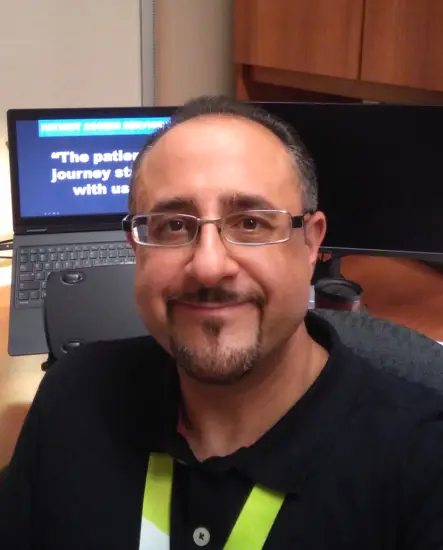An interview with Ehab Matta of PRNO

Ehab Matta is the Manager, Patient Access Services at Michael Garron Hospital/Toronto East Health Network and the former chair of the Patient Registration Network of Ontario (PRNO).
You chaired the Patient Registration Network of Ontario (PRNO) group for many years. During which time did you take this on?
I chaired PRNO from July 2005 to the 2018—for 13 years.
What changes did you observe in the membership of PRNO over that time period?
PRNO started within the GTA and grew to become a province-wide group. In the early days, registration was a second thought. Over time, registration increased in importance with EMR technology implementation, as it became recognized that registration is the first contact that the patient has with the organization. Hospital administration and the Ministry of Health became aware of the importance of establishing positive identification. It soon became evident that there were so many challenges for registration staff: customer service, professionalism, data quality, payment collection (direct impact on hospital finances). In the past, hospitals just didn’t think about registration when they were renovating, but this changed over the years with the understanding of the importance of registration and the need to standardize practices.
In what ways did the topics of discussion change over time?
Topics included how to support members since there was no governing organization for registration and that there were no standards for processes or comparable job descriptions. At some point, the legal name became an important topic of conversation and resulted in the group working with the Ministry, eHealth Ontario, and Service Ontario. The Patient Access Organization in the United States expressed interest in starting a chapter here representing Canada. Since we did not have the resources and the structure to expand, the opportunity to join other organizations was not feasible. There was also some interest from health care organization in British Columbia and Nova Scotia to join PRNO and to expand the group nationally, but again, without the appropriate resources it was not possible at that time.
At first, we met quarterly and then on a semi-annual basis when the meetings turned into mini-conferences with guest speakers and presenters. We were able to benchmark and standardize practices. There was increased interest in the centralization of registration to to improve operations, data quality and revenue. Here at Michael Garron Hospital, we improved data quality 72% just through centralization of registration. Some of the benefits of centralizing registration are: standardize registration practices, ability to cross train staff, establish a larger pool of staff, and the ability to offer more hours for part timers, with the result of enhanced staff retention.
What are the top two or three issues that PRNO addressed most frequently during your tenure as chair?
Standardizing policies and practices, as well as how to improve revenue and data quality. Other topics that came up frequently were: training staff relating to customer service, kiosks, and Ministry changes. We would discuss how to implement changes, such as transitioning from embossing patient ID cards to printed labels, armbands, changing health cards, monitoring and improving staff satisfaction, card swiping, links with the Ministry for validating information, changes to technology, and LGBTQ community challenges such as sex at birth, gender identity, and preferred name.
Do you think that PRNO has made a difference in terms of best practice for PRNO members?
Yes, absolutely.
Do you think that PRNO has made a difference in terms of best practice for patient access beyond PRNO—in Ontario and/or Canada?
Yes, for sure in Ontario, but I’m not sure if we could claim to have best practice country-wide.
Of all your accomplishments while leading this group, what are you most proud of?
Expanding the membership to over 80 health care organizations in Ontario, bringing patient access to the forefront in Ontario, helping organizations realize that patient registration is an important role, growth in centralized registration, and providing support to new managers in the field.
What was the biggest surprise during your time as chair?
Enthusiasm of new members—they are so excited to join! How much of an impact it made. If you asked me what the biggest frustration was, I would say the slow pace of getting organizations to see the value of centralization of registration, the importance of data quality, and the important role that registration has in impacting hospital revenue.
How does your participation in PRNO help support you in your role as a leader of patient registration in a downtown Toronto teaching hospital?
PRNO helps me in promoting the sharing of information, benchmarking, sharing best practices and standardization, and sharing communication. There is so much change ongoing, it is crucial to be able to discuss it with peers and figure out ‘how do we do this?’ so that we call all successfully implement the change.
If you could carve the future of PRNO, what would it look like?
There would be:
- A national group
- A type of association with all the tools to improve communication
- A certification program
- Annual CPE requirements
- Standardized practices that we all follow
Edited on August 18, 2020






